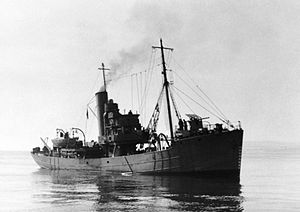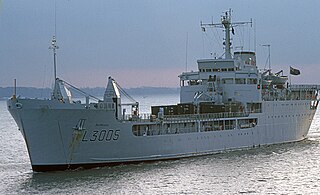
RFA Sir Galahad (L3005) was a Round Table-class landing ship logistics vessel belonging to the Royal Fleet Auxiliary (RFA) of the United Kingdom. The ship saw service in the Falklands War of 1982, where she was bombed and set afire at Fitzroy on 8 June.

HMS Bangor was a Bangor-class minesweeper of the Royal Navy that served during the Second World War. She was built at the Harland and Wolff shipyard in Govan, Scotland. Bangor was the lead vessel of her class and one of the diesel-engined versions. She was ordered on 12 July 1939, laid down on 19 September 1939, launched on 23 May 1940, and commissioned on 7 November 1940. She is named after the Northern Ireland seaside town of the same name.
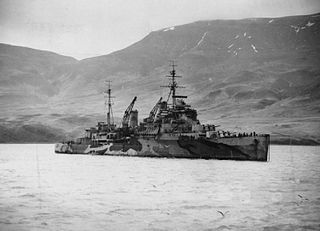
PQ 13 was a British Arctic convoy that delivered war supplies from the Western Allies to the USSR during World War II. The convoy was subject to attack by German air, U-boat and surface forces and suffered the loss of five ships, plus one escort vessel. Fifteen ships arrived safely.

A danlayer was a type of vessel assigned to minesweeping flotillas during and immediately after World War II. They were usually small trawlers, fitted for the purpose of laying dans. A dan is a marker buoy which consists of a long pole moored to the seabed and fitted to float vertically, usually with a coded flag at the top.
Vorpostenboot, also referred to as VP-Boats, flakships or outpost boats, were German patrol boats which served during both World Wars. They were used around coastal areas and in coastal operations, and were tasked with – among other things – coastal patrol, ship escort, and naval combat.

HMS Jason was a Halcyon-class minesweeper. She was named after the hero in Greek mythology and was the sixteenth Royal Navy ship to carry the name Jason. She was laid down on 12 December 1936, launched on 6 October 1937, and was completed on 9 June 1938. She survived the Second World War and was sold in 1946 to become a cargo ship. She was eventually broken up in 1950. Her pennant number was originally N99, but was changed to J99 in May 1940.
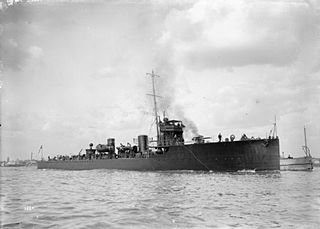
HMS Ariel was an Acheron-class destroyer built in 1911, which served during the First World War and sank in 1918 after striking a mine. Named after Shakespeare's "airy spirit", or the biblical spirit of the same name, she was the tenth and last ship of the name to serve in the Royal Navy.

The Round Table class was a small class of trawlers built for the British Royal Navy in 1941–1942. The class were built by two Aberdeen shipbuilding firms Hall, Russell & Company and J. Lewis & Sons Ltd.

HM Trawler Agate was purchased by the Royal Navy in 1935. She was modified from a trawler to be used to carry out anti-submarine work. In 1941 she was with the maintenance reserve at Rosyth, but in August was part of the Royal Navy's escort flotilla with convoy FS559 when she ran aground, becoming a total loss, on Haisborough Sands on 6 August with a loss of sixteen crewmen.

HM Trawler Alvis was a British trawler that was taken up from trade and used by the Royal Navy during the Second World War. She was returned to the fishing industry at the end of hostilities in 1945.
Events from the year 1957 in Scotland.

RNLB Emma Constance was a Barnett-class lifeboat stationed at Aberdeen Lifeboat Station, in the Scottish city of Aberdeen from 1927 until August 1951. The lifeboat was designed by James R. Barnett who was a consulting naval architect to the Royal National Lifeboat Institution (RNLI).

The Battle off Zuwarah was a naval night encounter during the Second World War. The battle took place in Libyan waters between the Royal Navy and the Regia Marina. An Italian flotilla of small minesweepers and auxiliary vessels evacuating Tripoli was destroyed by two British destroyers.
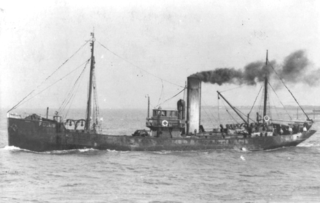
ST Pasages was originally a Canadian "Castle" – TR series minesweeping trawler built by the Dominion Shipbuilding Company, Toronto, in 1917 for service with the Royal Canadian Navy during World War I as TR 14. Following the war the vessel was taken to the United Kingdom and converted to a fishing trawler in the 1920s. Renamed Pasages, the vessel ran aground in 1931 on the Isle of Man. The vessel was wrecked and her remains can still be seen.
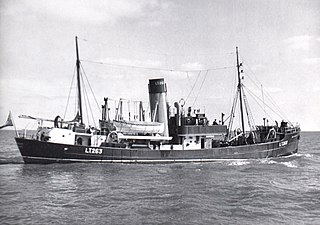
RV Sir Lancelot (LT263) was a fisheries research vessel that was operated by the Directorate of Fisheries, now known as the Centre for Environment, Fisheries and Aquaculture Science (Cefas).

HMS Sharpshooter was a Halcyon-class minesweeper of the British Royal Navy. Built at Devonport Dockyard, Sharpshooter was completed in 1937. She served through the Second World War, acting both in her designed role as minesweeper and as a convoy escort, escorting several Arctic convoys. She took part in the evacuation from Dunkirk in 1940, and sank the German submarine U-655 in 1942.
SS Ben Doran was a steam fishing trawler that operated out of Aberdeen, Scotland. It was launched in 1900 and operated until its wrecking on the Ve Skerries, Shetland, on 29 March 1930, which claimed the lives of the full crew, believed to number nine crew members. Its wrecking has been called "the most tragic wreck in all Shetland's history".
